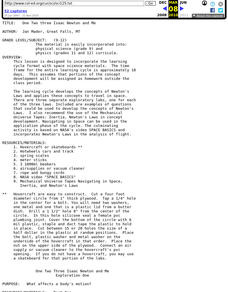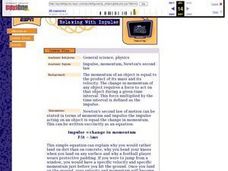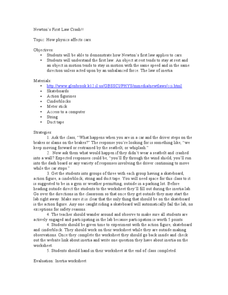Curated OER
Force Diagrams
Seeming incomplete, this slide show introduces physical science novices to the balancing of forces and drawing force diagrams. The first seven slides work well to meet this purpose. The remaining slides, however, turn viewers over to...
Curated OER
Sliding Mass Problems
Physics masters solve five sliding mass problems. For each, there are a few different values to be determined: normal force, force of friction, acceleration, velocity, coefficient of friction, or net force. Pupils must draw a force...
Curated OER
Rocketry
Students design and construct a paper rocket that can be launched with a drinking straw. They participate in a lecture and read an article about rocketry and how Newton's Third Law applies to rocket launches. Each student constructs...
Curated OER
Newton's Laws of Motion Crossword
In this Newton's Laws of Motion crossword puzzle instructional activity, students use the 13 clues and the terms in the word bank to help them correctly complete the word puzzle.
Curated OER
One, Two, Three--Isaac Newton and Me
Students experiment to develop understanding of Newton's Laws and how they apply to space travel in this ten day instructional activity sequence.
Curated OER
Newton's Laws of Motion
Ninth graders utilize Newton's Laws of Motion to explain how things move, create poster illustrating each law of motion, and present and explain their poster to classmates.
Curated OER
The Scientific Revolution: 1500-1700
Discover the key players involved in reshaping scientific thought during the scientific revolution. Basic information regarding major contributions of Brahe, Copernicus, Galileo, Bacon, Kepler, Descartes, and Newton are covered in this...
Curated OER
Crash Test Dummies
Fifth graders are introduced to Newton's First Law of Motion. In groups, they describe the differences between balanced and unbalanced forces. They participate in experiments that demonstrate how equal and opposite forces act upon...
Curated OER
Newton's Second Law of Motion with Simple Machines
First graders study Newton's Second Law of Motion before demonstrating the concept with a simple machine. They sing a song about speed, force, mass, and acceleration. They use simple machines to demonstrate how objects that have a higher...
Curated OER
Newton's Universal Law of Gravitation with Simple Machines
First graders engage in a lesson that is about Newton's Laws Of Gravitation while conducting research in order to perform an information search. They sing a song about the Law of Gravitation and play a game of Ring Around The Rosie. Then...
Curated OER
Newton's Second Law of Motion with Balance Toys
Students discuss acceleration and deceleration and participate in brief demonstrations of the Second Law of Motion. They apply the law to a metal balance toy and a plastic balance toy by applying the same force then with different forces.
Curated OER
Newton's 3 Laws of Motion
In this Newton's 3 laws of motion worksheet, students view examples of each law and draw 1 example of each law on their own. Students draw 3 pictures.
Curated OER
Alka Rockets
Students design a paper rocket propelled by Alka-Seltzer and water to demonstrate Newton's third law of motion. They, in pairs, determine the best combination of Alka-Seltzer and water to produce the maximum launch height and record...
Curated OER
Relaxing with Impulse
Students discuss Newton's second law of motion in terms of momentum and impulse using examples of landing on concrete versus dirt if you were to jump off an elevated platform or football players wearing protective padding. Mathematical...
Curated OER
Walking on Water
Students use this problem to help them to relate to force vectors: Suspend a meterstick horizontally between two tables. Place a 1kg mass in the middle of the meterstick. Notice the bend of the meterstick. Explain why the meterstick...
Curated OER
When Earth Fails: How Earth?s Physical Changes Cause Natural Disasters
Students examine natural disasters and some safety measures that should be followed. In this natural disaster instructional activity students write a narrative, and research safety procedures.
Curated OER
Mathematics at the Frontier of Astronomy
Students explore the different types of measurements used in astronomy. In this space science lesson, students explain the relationship between planets' orbits and distance from the sun using Kepler's Laws. They discuss how math aides in...
Curated OER
Science in Focus: Force and Motion
Students explore force and motion through a series of experiments. In this physics lesson, students create and interpret speed graphs. They build an electromagnet and explain the factors affecting its strength.
Curated OER
Newton's First Law Crash!!
Students examine Newton's first law of motion and demonstrate how it applies to cars. In this motion lesson students complete an experiment and worksheet on speed and inertia.
Curated OER
Gravitational Acceleration
Students investigate the interdependence of mass and gravitational acceleration using computer simulation. In this physics lesson, students derive the formula for acceleration due to gravity. They calculate air resistance on falling...
Curated OER
Newton Gets Me Moving
Fourth graders experiment with Newton's three laws of motion. In this motion lesson, 4th graders explore the three laws of motion and then work in small groups collaborating while experimenting with these laws. Numerous resources are...
Curated OER
Blast Off!
Fourth graders investigate the third law of motion. In this third law of motion lesson, 4th graders explore the forces necessary for a rocket to launch. Students compare and contrast propellant and fuel. Numerous resources are provided.
Curated OER
The Solar System
Third graders investigate Newton's law of Motion. In this chemical reaction lesson, 3rd graders participate in an experiment with rockets to study Newton's law. Students observe the effects of a chemical reaction made by combining...
Curated OER
Isaac Newton's Third Law of Motion
Ninth graders experiment with Isaac Newton's Third Law of Motion. In this Third Law of Motion lesson, 9th graders develop an experiment that shows their understanding of this theorem. They work in small groups to read an article at a...

























